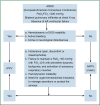Noninvasive positive pressure ventilation for the treatment of acute respiratory distress syndrome following esophagectomy for esophageal cancer: a clinical comparative study
- PMID: 24409355
- PMCID: PMC3886700
- DOI: 10.3978/j.issn.2072-1439.2013.09.09
Noninvasive positive pressure ventilation for the treatment of acute respiratory distress syndrome following esophagectomy for esophageal cancer: a clinical comparative study
Abstract
Objective: To evaluate the therapeutic efficacy of noninvasive positive pressure ventilation (NPPV) in the treatment of acute respiratory distress syndrome (ARDS) following esophagectomy for esophageal cancer.
Methods: In this retrospective evaluation, we included 64 patients with ARDS following esophagectomy for esophageal cancer between January 2009 and December 2011. The primary evaluations were 28-day fatality and actual fatality. The secondary evaluations were sex, age, onset time, pH value, PaO2/FiO2, sequential organ failure assessment (SOFA) score, acute physiology and chronic health evaluation (APACHE-II) score, and presence or absence after surgery of major surgery-related complications such as cardiac arrest, anastomotic fistula, and acute renal dysfunction.
Results: NPPV applied as the first-line intervention for ARDS following esophagectomy for esophageal cancer avoided intubation in 30 patients (30/64, 48.4%). There were no significant differences in gender, age, PaO2/FiO2, SOFA score, or APACHE-II score between the NPPV group and the patients who required invasive positive pressure ventilation (IPPV group) (P>0.05) at the time of onset, while differences in the PaO2/FiO2 (P<0.05) after 24 h of NPPV and presence of major surgery-related complications were highly significant (P<0.01).
Conclusions: NPPV may be an effective option for the treatment of ARDS/acute lung injury (ALI) following esophagectomy for esophageal cancer. However, conversion to invasive mechanical ventilation should be considered in patients with severe postoperative complications such as acute renal dysfunction and cardiac arrest and in those with PaO2/FiO2 <180 after 2 h of NPPV.
Keywords: Noninvasive positive pressure ventilation (NPPV); acute respiratory distress syndrome (ARDS); esophagectomy.
Figures
Similar articles
-
A multiple-center survey on the use in clinical practice of noninvasive ventilation as a first-line intervention for acute respiratory distress syndrome.Crit Care Med. 2007 Jan;35(1):18-25. doi: 10.1097/01.CCM.0000251821.44259.F3. Crit Care Med. 2007. PMID: 17133177
-
Noninvasive positive pressure ventilation: successful outcome in patients with acute lung injury/ARDS.Chest. 1999 Jan;115(1):173-7. doi: 10.1378/chest.115.1.173. Chest. 1999. PMID: 9925080
-
Efficacy and safety of noninvasive positive pressure ventilation in the treatment of acute respiratory failure after cardiac surgery.Chin Med J (Engl). 2013 Dec;126(23):4463-9. Chin Med J (Engl). 2013. PMID: 24286408 Clinical Trial.
-
Acute Respiratory Distress Syndrome: Advances in Diagnosis and Treatment.JAMA. 2018 Feb 20;319(7):698-710. doi: 10.1001/jama.2017.21907. JAMA. 2018. PMID: 29466596 Review.
-
Indications for mechanical ventilation in adults with acute respiratory failure.Respir Care. 2002 Mar;47(3):249-62; discussion 262-5. Respir Care. 2002. PMID: 11874605 Review.
Cited by
-
High flow nasal oxygen vs. conventional oxygen therapy over respiratory oxygenation index after esophagectomy: an observational study.J Thorac Dis. 2024 Feb 29;16(2):997-1008. doi: 10.21037/jtd-23-1176. Epub 2024 Feb 4. J Thorac Dis. 2024. PMID: 38505084 Free PMC article.
-
Effect of sedation on short-term and long-term outcomes of critically ill patients with acute respiratory insufficiency.World J Emerg Med. 2015;6(2):147-52. doi: 10.5847/wjem.j.1920-8642.2015.02.011. World J Emerg Med. 2015. PMID: 26056547 Free PMC article.
-
Non-invasive mechanical ventilation in postoperative esophagectomy. Is a safe and efficacy indication always?J Thorac Dis. 2014 May;6(5):E58-9. doi: 10.3978/j.issn.2072-1439.2014.03.17. J Thorac Dis. 2014. PMID: 24822127 Free PMC article. No abstract available.
-
Effects of non-invasive ventilation in patients with acute respiratory failure excluding post-extubation respiratory failure, cardiogenic pulmonary edema and exacerbation of COPD: a systematic review and meta-analysis.J Anesth. 2017 Oct;31(5):714-725. doi: 10.1007/s00540-017-2389-0. Epub 2017 Jul 24. J Anesth. 2017. PMID: 28741217
-
Peri-operative approach to esophagectomy: a narrative review from the anesthesiological standpoint.J Thorac Dis. 2021 Oct;13(10):6037-6051. doi: 10.21037/jtd-21-940. J Thorac Dis. 2021. PMID: 34795950 Free PMC article. Review.
References
-
- Zhang Z.Protective ventilation for patients without acute respiratory distress syndrome. JAMA 2013;309:654. - PubMed
-
- Soma K.Acute respiratory distress syndrome and pneumonia. Masui 2013;62:547-56 - PubMed
-
- Solsona Durán JF, Basas Satorras M, Zapatero Ferrándiz A, et al. Acute respiratory distress syndrome criteria. Med Intensiva 2013;37:124. - PubMed
-
- Sigurdsson MI, Sigvaldason K, Gunnarsson TS, et al. Acute respiratory distress syndrome: nationwide changes in incidence, treatment and mortality over 23 years. Acta Anaesthesiol Scand 2013;57:37-45 - PubMed
LinkOut - more resources
Full Text Sources


